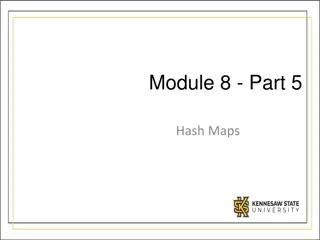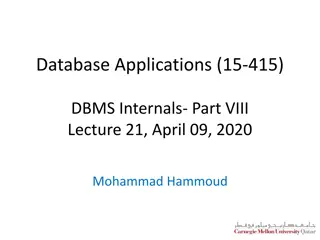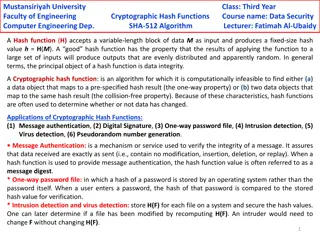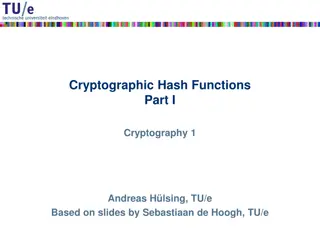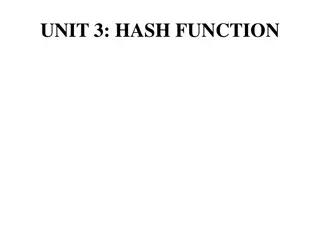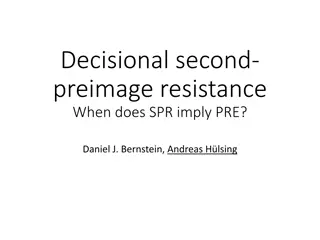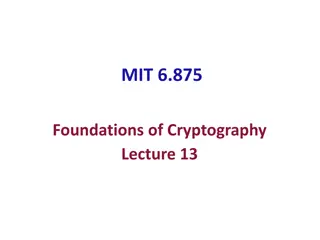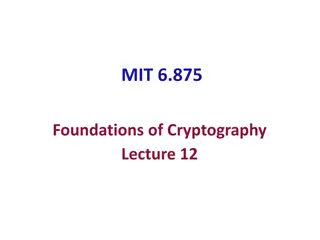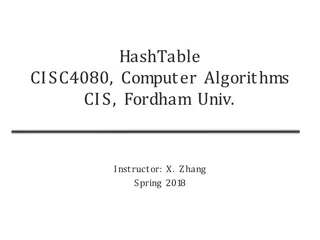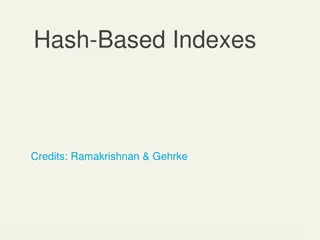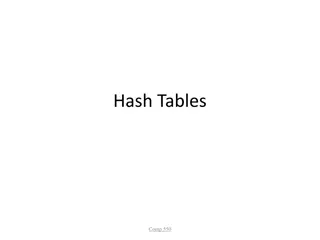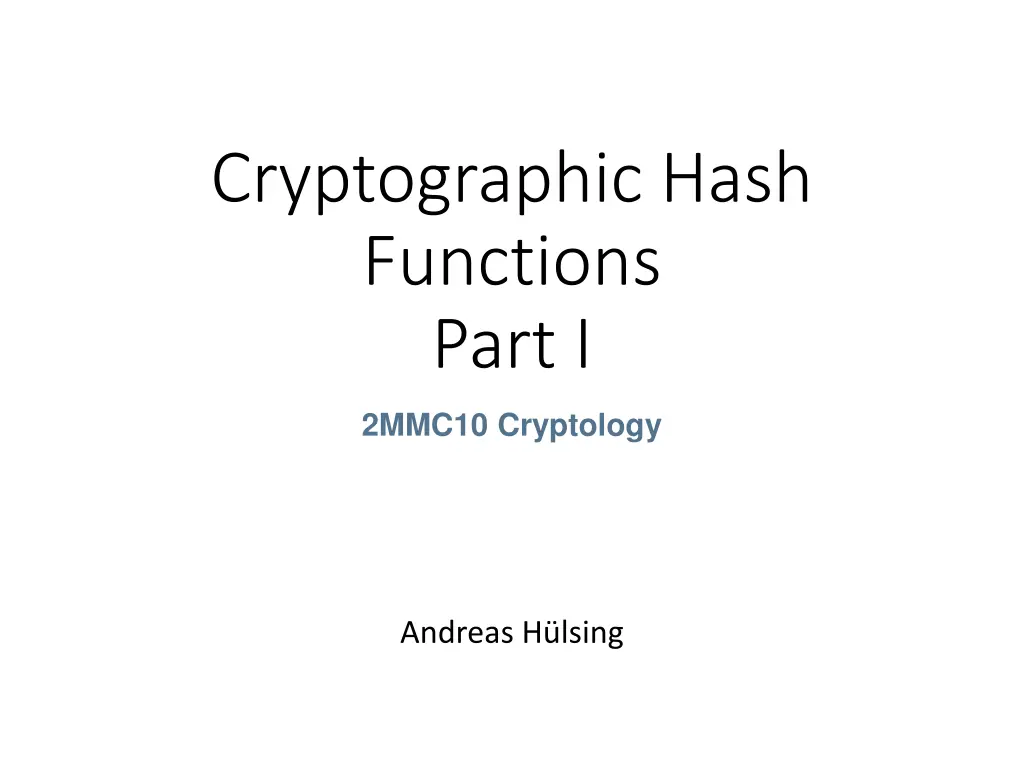
Understanding Cryptographic Hash Functions and Their Applications
Learn about cryptographic hash functions, including how they are used for integrity protection, checksums, password hashing, MACs, digital signatures, and more. Explore the properties like collision resistance and preimage resistance that define their security.
Download Presentation

Please find below an Image/Link to download the presentation.
The content on the website is provided AS IS for your information and personal use only. It may not be sold, licensed, or shared on other websites without obtaining consent from the author. If you encounter any issues during the download, it is possible that the publisher has removed the file from their server.
You are allowed to download the files provided on this website for personal or commercial use, subject to the condition that they are used lawfully. All files are the property of their respective owners.
The content on the website is provided AS IS for your information and personal use only. It may not be sold, licensed, or shared on other websites without obtaining consent from the author.
E N D
Presentation Transcript
Cryptographic Hash Functions Part I 2MMC10 Cryptology Andreas H lsing
How are hash functions used? integrity protection cryptographic checksum (e.g. software downloads) for file system integrity (Bit-torrent, git) password hashing dedicated algorithms like scrypt / argon2 use hash functions as building block MAC message authentication codes Digital signature ( public key MAC ) Password-based key derivation Pseudo-random number generation (PRG) 2
What is a hash function? - Applied answer Function ?: ?,? ?,?? Input: bit string x of arbitrary length length may be 0 in practice a very large bound on the length is imposed, such as 264 ( 2.1 million TB) input often called the message Output: bit string h(x) of fixed length n e.g. n = 128, 160, 224, 256, 384, 512 compression output often called hash value, message digest, fingerprint h(x) is efficiently computable given x no secret information, no secret key 3
Intermezzo: Formal treatment Efficient Algorithm Runs in polynomial time, i.e. for input of length n, tA nk = poly(n) for some constant k Probabilistic Polynomial Time (PPT) Algorithm: Randomized Algorithm Runs in polynomial time Outputs the right solution with some probability Negligible: Vanishes faster than inverse polynomial We call ? ? negligible if ? ??> ? ? > ??:? ? < ????(?) 4
What is a hash function? - Formal answer Efficient keyed function h: 0,1? 0,1?(?) 0,1? We write h k,x = ?(?) Key ? in this case is public information. Think of function description. 5
Security properties: Collision resistance Collision resistance (CR): For any PPT adversary A, the following probability is negligible in n: ??[? ? 0,1?, ?1,?2 ? ? : ??1 = ??2 ?1 ?2] 6
Security properties: Preimage resistance / One-wayness Preimage resistance (PRE): For any PPT adversary A, the following probability is negligible in n: ??[? ? 0,1?,? ? 0,1? ?,? ?? , ? ? ?,? : ?? = ?] 7
Formal security properties: Second-preimage resistance Second-preimage resistance: For any PPT adversary A, the following probability is negligible in n: ??[? ? 0,1?,? ? 0,1? ?,? ? ?,? : ?? = ?? ? ? ] 8
Reductions Transform an algorithm for problem 1 into an algorithm for problem 2. Reduces problem 2 to problem 1 (I can solve problem 2 by solving problem 1) Allows to relate the hardness of problems: If there exists an efficient reduction that reduces problem 2 to problem 1 then an efficient algorithm solving problem 1 can be used to efficiently solve problem 2. 9
Reductions II Use in cryptography: Relate security properties Provable Security : Reduce an assumed to be hard problem to breaking the security of your scheme. Actually this does not proof security! Only shows that scheme is secure IF the problem is hard. (Intuition: It shows, I can solve my problem by breaking the security of the scheme) 10
Relations between hash function security properties 11
Easy start: CR -> SPR Theorem (informal): If h is collision resistant then it is second preimage resistant. Proof: By contradiction: Assume A breaks SPR of h then we can build a reduction MA that breaks CR. Given key k, MA first samples random ? 0,1?(?) MA runs ? ? ?,? and outputs ?,? MA runs in approx. same time as A and has same success probability. -> Tight reduction 12
SPR -> PRE ? Theorem (informal): If h is second-preimage resistant then it is also preimage resistant. Proof: By contradiction: Assume A breaks PRE of h then we can build a reduction MA that breaks SPR. Given key k, x, MA runs ? ? ?, ?(?) and outputs ?,? MA runs in same time as A and has same success probability. Do you find the mistake? 13
SPR -> PRE ? Theorem (informal): If h is second-preimage resistant then it is also preimage resistant. Counter example: the identity functionid : 0,1? 0,1? is SPR but not PRE. 14
SPR -> PRE ? Theorem (informal): If h is second-preimage resistant then it is also preimage resistant. Proof: By contradiction: Assume A breaks PRE of h then we can build an oracle machine MA that breaks SPR. Given key k, x, MA runs ? ? ?, ?(?) and outputs ?,? MA runs in same time as A and has same success probability. Do you find the mistake? We are not guaranteed that ? ? ! 15
SPR -> PRE ? Theorem (informal, corrected): If is second-preimage resistant, ? ? ?, then it is also preimage resistant. Proof: By contradiction: Assume A breaks PRE of then we can build an oracle machine MA that breaks SPR. Given key k, x, MA runs ? ? ?, ?(?) and outputs ?,? MA runs in same time as A and has at least half the success probability. Can replace condition ? ? ? by requiring that h is decisional second preimage resistant . Same corrections have to be applied for CR -> PRE 16
Summary: Relations Stronger assumption / easier to break Collision-Resistance Assumption / 2nd-Preimage- Resistance Attacks weaker assumption/ harder to break One-way 17
generic (brute force) attacks assume: hash function behaves like random function preimages and second preimages can be found by random guessing search space: n bits, 2n hash function calls collisions can be found by birthdaying search space: n bits, 2 n hash function calls this is a big difference MD5 is a 128 bit hash function (second) preimage random search: 2128 3x1038 MD5 calls collision birthday search: only 264 2x1019 MD5 calls 18
birthday paradox birthday paradox given a set of t ( 10) elements take a sample of size k (drawn with repetition) in order to get a probability on a collision (i.e. an element drawn at least twice) k has to be > 1.2 ? consequence if ? ? ? is a surjective random function and |?| |?| then one can expect a collision after about |?| random function calls 19
meaningful birthdaying random birthdaying do exhaustive search on n/2 bits messages will be random messages will not be meaningful Yuval (1979) start with two meaningful messages m1, m2 for which you want to find a collision identify n/2 independent positions where the messages can be changed at bit level without changing the meaning e.g. tab space, space newline, etc. do random search on those positions 20
implementing birthdaying na ve store 2n/2 possible messages for m1 and 2n/2 possible messages for m2 and check all 2n pairs less na ve store 2n/2 possible messages for m1 and for each possible m2 check whether its hash is in the list smart: Pollard- with Floyd s cycle finding algorithm computational complexity still O(2n/2) but only constant small storage required 21
Pollard- and Floyd cycle finding Pollard- iterate the hash function: a0, a1 = h(a0), a2 = h(a1), a3 = h(a2), this is ultimately periodic: there are minimal t, p such that at+p = at theory of random functions: both t, p are of size 2n/2 Floyd s cycle finding algorithm Floyd: start with (a1,a2) and compute (a2,a4), (a3,a6), (a4,a8), , (aq,a2q) until a2q = aq; this happens for some q < t + p 22

